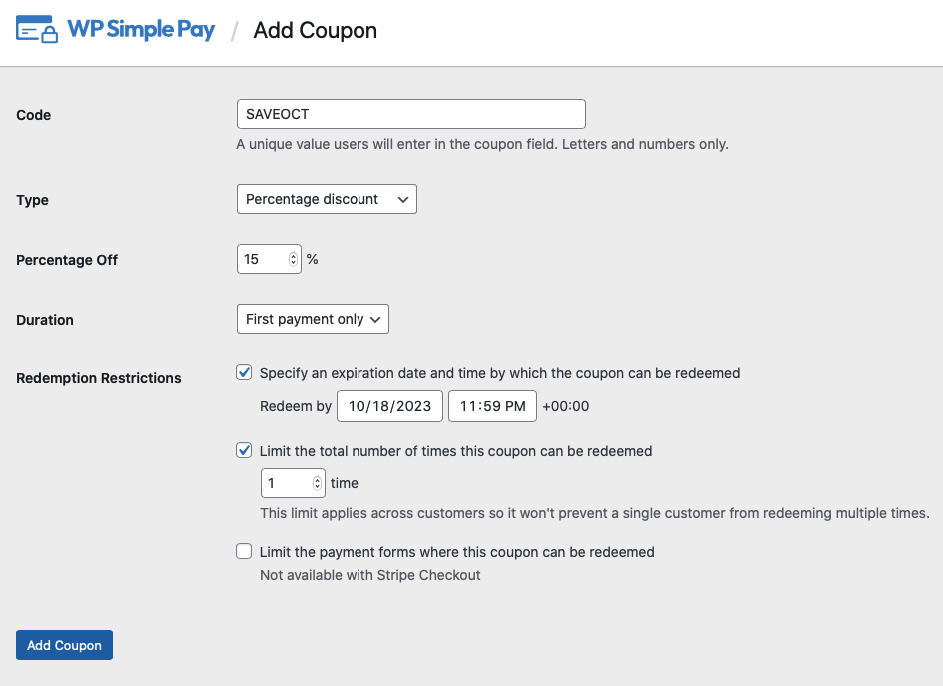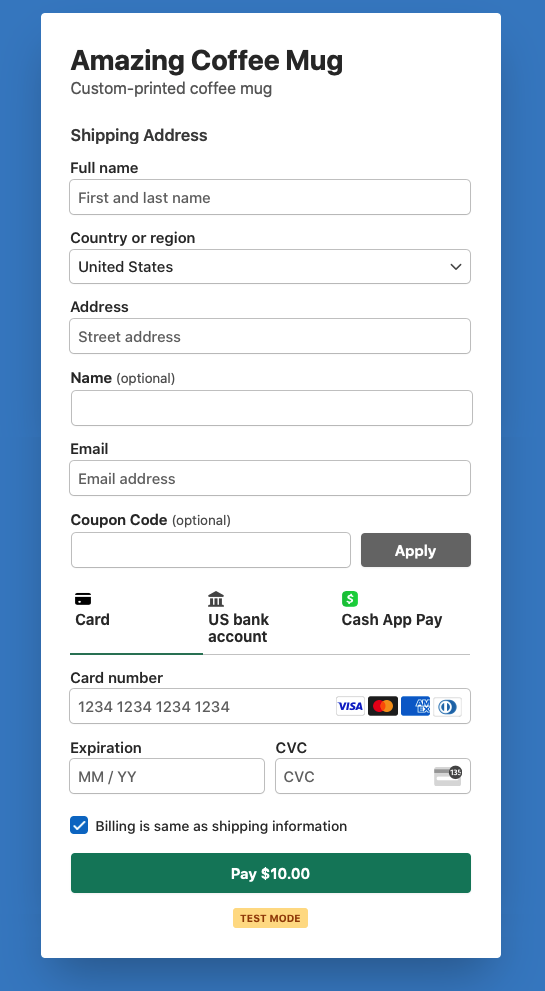7+ Ways to Maximize Coupons on Your WordPress Site
Last updated on
Are you wanting to offer coupons and discounts on your WordPress site?
Offering coupons and discounts on your eCommerce site can help give you an edge over your competitors, attract new customers, and boost sales.
In this article, we’ll go over a few essential strategies to consider when offering coupons and discounts on your site so you can create the most value for your business.
Table of Contents
- Offering Coupons & Discounts On Your Site
- 1. Include an Expiration Date
- 2. Keep Your Offer Clear and Simple
- 3. Avoid Coupon Fatigue
- 4. People Want Discounts, Not Freebies
- 5. Pull New Customers Into Your Brand
- 6. Consider All Your Variables
- Using WP Simple Pay to Create Coupon Codes
- Measure and Test Your Results
- Going Forward
Offering Coupons & Discounts On Your Site
Undoubtedly, people love coupons and discounts. Afterall, who wants to pay full asking price when they could pay less?
So, it’s no wonder that over 85% of online consumers reported that they were influenced to make a purchase when a coupon code was offered.
While offering coupons is an effective way to drive sales and improve customer loyalty throughout the year, many businesses use them during the holidays to promote sales and special offers.
With all that being said, simply creating coupons for your site isn’t enough. You need to be strategic with them if you want to drive maximum revenue.
Let’s take a look at a few ways you can ensure that you’re maximizing the full potential of coupons and discounts.
1. Include an Expiration Date
Every discount you give out should include an expiration date. This applies to general coupons you offer on the web and single-use discounts you give to individuals.
Why should coupons expire? Because expirations play on your customers’ fear of missing out, which is their innate fear that they won’t get to use a resource or benefit. By putting an end date on your coupon offer, you push on that nerve so people feel compelled to use it before it’s unavailable.
Of course, this only works if your expiration dates are obvious. Marketers used to bury their expiration dates in the fine print at the bottom of the coupon, but now we know that it’s a key piece of information that belongs right near the offer.
2. Keep Your Offer Clear and Simple
When it comes to designing your offer, less is definitely more. Customers often find complex promotions confusing. Once you start introducing variations, tiers, or rules, most customers will…
- Fail to understand the offer.
- Suspect the complexity means you’re taking advantage of them.
- Decide that studying your offer isn’t worth their time.
Here’s a great discount offer: The first 50 people to buy the course will get 20% off.
Here’s a terrible discount offer: The first 50 people to sign up will enter a drawing for 500 in-app credits after registering the product and processing 25 transactions, or two hours of consulting time with one of our experts.
The bad offer is long and complex. Most importantly, it’s hard to understand. How much is 500 credits or two consulting hours actually worth? How long does it take to register and process 25 transactions? There are just too many variables to understand the offer’s value.
3. Avoid Coupon Fatigue
After a few successful discount campaigns, you might be tempted to run them all the time. This happens to a lot of businesses who have good margins and don’t mind giving up a tiny piece of each sale for a lot more sales.
But, there are two reasons you shouldn’t give out coupons too often.
First, customers can grow fatigued by coupons. There’s nothing special about your offers if they happen every week. It’s similar to those car dealership radio commercials who constantly “order too much inventory.”
Customers will start to ignore your promotions, including emails, social media posts, and banner ads, if you bombard them with “special deals” that aren’t unique or rare.
Furthermore, constant sales devalue your products and services. If you sell a service for $200, but offer a 20% off coupon every week, then the service isn’t really worth $200. It’s only worth $160. Customers will never buy at full price because they know they only need to wait a short time before you give them a discount.
How often should you give out coupons and discounts? That’s hard to say. It depends on your business, products, and customers. It makes sense to give out regular coupons for commodity products with a lot of competition. But an enterprise software consultant, for example, should almost never discount their services.
4. People Want Discounts, Not Freebies
Recent studies show that at least 60% of buyers prefer discounts over any other type of promotional offer. Rebates, free gifts, special access, gift cards, and other incentive offers can work in some cases, but most people just want to be charged less.
For best results, don’t get fancy with your coupons. Give your customers simple offers, like percentage discounts (e.g. 20% off) or flat discounts (e.g. $50 off).
When it comes to discounts, the best kind is free shipping. Sixty-two percent of online shoppers reported that they don’t consider purchasing from a site that doesn’t offer free shipping. So, to ensure that you increase your sales, you should consider offering free shipping across the board.
5. Pull New Customers Into Your Brand
Coupons and discounts have value beyond the immediate sale. You can use them to bring more people into your marketing umbrella by requiring them to opt in to your email list in exchange for the coupon.
In fact, 42.3% of Americans subscribe to email lists to receive savings and discounts, while about 1 in 3 U.S. retail email list subscribers have purchased something from the brand whose emails they receive.
The biggest advantage here is that you grow your audience even if new subscribers decide not to use the coupon. You can serve them email content over time to eventually turn them into customers.
6. Consider All Your Variables
If a coupon or discount doesn’t drive the revenue you hoped it would, you might be tempted to boost the discount. If 10% doesn’t excite people, maybe 20% will, right?
That may be the case, but you don’t always have to serve up a bigger coupon. There are other variables you should consider, like the duration of the offer, its terms, or whether you promoted it to the right people. You should also consider the reason you felt the need to discount the product or service in the first place.
For example, let’s say you’re offering a coupon for a membership course that doesn’t sell, but no one used the coupon. The price of the course may be an issue, but there’s also a chance your customers don’t find it valuable or don’t need it badly enough.
The timing of your offer can be critical, as well. Instead of offering big discounts six times a year, you may have more success by offering a single discount at the right time.
For example, if you know that your customer gets busy during a certain month, sending out a small coupon for your time-saving products during that month could be far more effective than a big coupon at any other time.
So, before you start eroding your margins by offering bigger discounts, consider all of the other variables about your offer and the product or service itself.
Using WP Simple Pay to Create Coupon Codes
Now that you’ve learned a few best practices for offering coupons on your site, let’s quickly go over the easiest way to add coupon codes and discounts to your payment forms.
Using WP Simple Pay, the best Stripe payments plugin for WordPress, you can create payment forms for products, services, fundraisers, event registrations, and more without having to set up a shopping cart.
One of the best parts about the plugin is that it allows you to add percentage and fixed amount discounts directly to your payment forms from the WordPress admin dashboard. You can also set the duration of the coupon code before it expires, and how many times a customer can redeem it.
After you’ve created a payment form with WP Simple Pay’s advanced drag-and-drop form builder, all you need to do to add a coupon code is simply navigate to WP Simple Pay → Coupons.
Once you’ve clicked on the Add New button, you can enter a unique code your customers will need to have the discount code applied, percentage or fixed amounts, the duration, and redemption restrictions.

The plugin makes it easy for you to add the newly-created coupon code to any payment form. Simply check the box next to Limit the payment forms where this coupon can be redeemed, and search for the payment forms that you want to have a coupon code.
Once you’ve created your coupon code, you can return back to the payment form to preview it, and then publish it on your site.
Below is an example of a payment form with a coupon code field.

Measure and Test Your Results
Our final piece of advice is the most important: measure and test the results of your coupon and discount campaigns. Which ones do your customers respond to the best? When are they most receptive to those offers? Which channels (social, email, direct mail, etc.) are the best ways to deliver your offers?
With careful observation, you should be able to see trends over time. This will help you optimize your campaigns so you deliver targeted discounts that drive sales without over-discounting.
You can track your coupon codes and the number of redemptions straight from the WordPress admin dashboard.

Going Forward
When used properly, coupons and discounts are powerful tools to drive revenue and grow your customer base. But in order to get the most value out of them, you need to use them strategically. If you follow the advice we’ve outlined in this article, you’ll grow sales and delight your customers.
If you liked this article, you might also want to check out our guide on how to automate recent sale notification popups in WordPress.
What are you waiting for? Get started with WP Simple Pay today!
To read more articles like this, follow us on X.
Disclosure: Our content is reader-supported. This means if you click on some of our links, then we may earn a commission. We only recommend products that we believe will add value to our readers.


